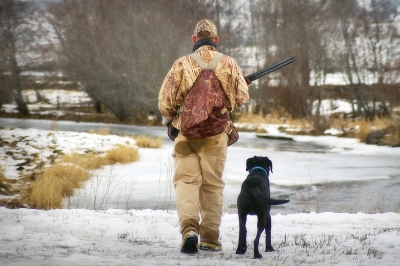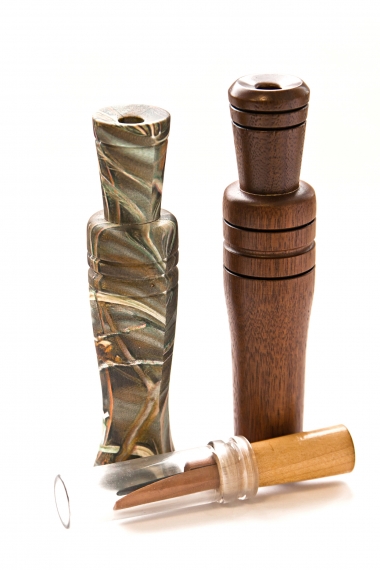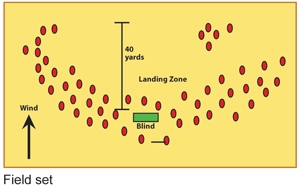
How to hunt waterfowl
Oregon supports diverse waterfowl populations, from sea ducks in coastal saltwater to puddle ducks in the alkali basins of southeast Oregon. You might think you need lots of gear (decoys, boats, a trained dog) to hunt ducks and geese, but you don’t. All of these things are nice but not necessary. All you really need is a hunting license/tag, shotgun, shells and some basic identification skills.

License requirements
To hunt waterfowl, you'll need a valid hunting license, free Harvest Information Program (HIP) validation, state waterfowl or non-resident game bird validation, and federal duck stamp (if 16 years and older) Purchase Federal duck stamp here.
A sea duck permit is needed to hunt harlequin, scoter, long-tailed and eider ducks.
A Northwest Oregon Goose Permit is required to hunt geese in the northwest portion of Oregon during the regular fall season. You will receive a Northwest Oregon Goose certification after passing a goose test showing you can distinguish between specific types of geese, including the dusky Canada geese, a sensitive population that winters in northwest Oregon. See the Oregon Game Bird Regulations for details.
When to hunt
Check the current Oregon Game Bird Regulations for season openings. In addition, there is a short, Canada goose-only season in September in designated areas. Generally, waterfowl hunting is best when weather conditions are poor. Wind and rain will force birds to move off standing water to seek shelter and to fly low, making your shot easier.
Where to hunt
Check out ODFW’s Hunting Access Map online to find out where you can go waterfowl hunting. Several state wildlife areas and federal refuges were created to provide habitat for waterfowl and these usually allow hunting. Some private lands are also open to public hunting access, thanks to special ODFW programs. You can also try knocking on doors of landowners where you see ducks or geese and ask for permission to hunt. Remember you are responsible for knowing boundaries and regulations for your hunting area and you must get permission to hunt on private lands. Most wildlife areas and refuges require hunters to use federally-approved, nontoxic shot, obtain daily hunting permits and may also have harvest check stations.
Hunting techniques
There are three general ways to hunt waterfowl— hunting over decoys, jump-shooting, and pass-shooting. Jump-shooting is sneaking within shotgun range of feeding or resting waterfowl. The birds are then flushed (e.g. they start flying up) and the hunter selects one as a target. This technique can be very productive when visiting a number of small ponds or walking along a small meandering stream or irrigation canal. When pass shooting, hunters try to position themselves in areas where ducks or geese are flying over as they go between feeding and resting areas. This can be a good technique under some circumstances, such as very windy days when birds are forced to fly low. On fair weather days, most birds fly too high and are out of shotgun range, making this technique less effective than jump-shooting or hunting over decoys.
Hunting over decoys is the classic way to hunt waterfowl. Hunters place decoys in a spot likely to be used by waterfowl, hide near the decoys, and try to entice passing birds to within shotgun range (by using calls, for example). Don’t think you need lots of decoys and an elaborate blind to hide in to use this method. Many waterfowl hunters, particularly on smaller water bodies, use as few as six decoys, hide in whatever nearby vegetation is available, and may not try to call the birds at all. Set up with the wind at your back, this way the birds will approach the decoys in front of you. Hunting over decoys has its advantages. As the birds are “working” the decoys (circling them to determine if it's safe to land) hunters can identify what kind of birds they are. Also, birds will often try to land with the decoys, which brings them well within shotgun range. See “Decoying Waterfowl” section for tips on how to set decoys.
Equipment
Hunters usually wear drab or camouflage clothing because waterfowl have excellent eyesight. Hip boots and chest waders, though not necessary, are ideal for retrieving birds that have fallen in water. Retrieving dogs also can help locate and retrieve ducks that fall in the water or heavy vegetation. Use any shotgun you like; 12 and 20 gauge are the most popular. Realize your gun will be exposed to mud, water and other elements. Also, state and federal law mandates that non-toxic shot be used for all waterfowl hunting. Steel is the most popular and least expensive of the non-toxic shot available for hunting.
Hunting safely
- Always know the location of your fellow hunters, including your dog.
- Keep your firearm’s muzzle pointed in a safe direction at all times.
- Keep your finger outside of the trigger guard until ready to shoot.
- Treat every firearm as if it were loaded.
- Be sure of your target: what is in front of it and beyond it.
Decoying Waterfowl
Properly placing your decoys is essential for hunting success. In general, decoys should be no farther than 40 yards away from the blind. This will help you judge distance and make good shots on approaching birds. Decoys should be distributed to allow one or two landing zones close to the blind. When setting out decoy spreads and locating your blind, it's important to remember that birds will always land coming into the wind. Here are some examples of decoy placements for water and field sets. Whether you have six decoys or six dozen, the basics of setting decoys remain the same. You want to have the wind at your back and the decoys in front, with an open area where you expect the birds will try to land.
When hunting on large ponds, or rivers with currents, be sure your decoy lines are not worn, are securely tied and have weights heavy enough to hold the decoy in place. When duck hunting, many species will respond well to mallard decoys. However, having groups of decoys of other species in your spread can improve your success.
Motion can also improve your success. Ducks move constantly when on the water, creating ripples on the water and flashes of white as they stretch their wings and flutter about. This motion on the water attracts ducks from great distances and helps convince the birds that your spread of decoys is a group of real ducks. Jerk rigs and spin-wing decoys are popular in Oregon for creating motion. Remember, motorized decoys and ripple-making devices are illegal in Oregon. All motion must be human powered.
Protect yourself
Just like people, birds sometimes get the flu and usually this is no cause for concern. The highly pathogenic avian influenza (HPAI) type H5N1 has been detected in North America since late 2021. The risk of this strain of avian flu to people is extremely low. The only known cases involved two people who were in close contact with domestic poultry. Still, hunters should follow routine hygiene precautions when dressing waterfowl and other game. There are no known cases of domestic dogs becoming sickened by contact with sick birds. But hunters should not feed dogs any raw meat, organs or other tissue from harvested waterfowl or allow retrieving dogs to interact with sick or dead birds. Hunters should follow routine hygiene precautions when dressing waterfowl and other game:
- Wear rubber or latex gloves when handling and cleaning game birds.
- Do not eat, drink, smoke or touch your face when handling birds.
- Keep the game bird and its juices away from other foods.
- Thoroughly clean knives and any other equipment or surfaces that touch birds. Use a solution of one third cup of chlorine bleach per one gallon of water.
- Wash your hands with soap and water for at least 20 seconds after handling birds (or with alcohol-based hand products if your hands are not visibly soiled).
Dressing your bird
Remember wildlife laws require that you leave one wing or the head of the bird attached during transport. Leave one of these on until you get your bird home.
- Pluck feathers on lower breast and abdomen.
- Cut through the belly skin at base of breast.
- Bend bird backwards and remove all entrails.
- Pluck feathers or remove feathery cape.
- Dry bird and keep it cool until you get it home, then refrigerate until cooking.
Cooking Duck
In the kitchen, savvy wild game chefs know that ducks are technically poultry, but it’s best to treat duck more like beef than chicken. That’s because ducks need to fly hundreds of miles per day during annual migrations and develop breast muscles that contain up to 80% myoglobin-rich, dark red muscle fibers compared to just 10% of those fibers in chicken. When cooked beyond medium, the rich blood in duck breast turns dark and tends to taste “livery”. As a rule, cook duck breasts like you would a fine steak, and cook duck legs like you would a good braising cut of beef.
Seared Duck Breast
Trim skin-on duck breast. Season with salt as you would a nice steak. Heat butter and oil in a pan on medium low. Place the duck breast skin side down on the pan and hold it there for about 15 seconds with your finger – like diner chefs hold down bacon. This will keep the duck breast from curling up. Let the duck cook a few minutes on very low heat until the skin crisps. Flip the duck and continue cooking in the pan until internal temperature reaches between 135 – 145 degrees F. Remove the duck breast, let it rest tented with foil, then slice thickly and serve as you would a steak. Sprinkle lightly with salt and pepper to finish.
Mother’s Wild Duck Recipe
Used continuously by family of Peter L. Barnhisel since the early 1920s, first in Klamath Falls and then Corvallis.
Shoot duck. Pick, clean and wash duck. Liberally salt and pepper cavity. Stuff cavity with 2 chunks each of onion, celery, orange and a garlic clove, cut in half. The cavity should be firmly filled with these chunks. Rub duck skin with lemon juice, then olive oil, and lightly salt the skin. Bake at 480ºF for 20 to 35 minutes, depending on the size of the bird. Serve hot, one duck per person, with wild rice and a stuffed tomato or asparagus.







